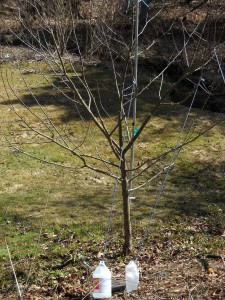Working On Apple Trees
Conventional wisdom has it that pruning apple and pear trees is best done before the flower and leaf buds open. This year many apples and pears are blossoming very early – even before we’ve had a chance to tune them up with an annual haircut.
I spoke recently with UNH Extension fruit tree expert Bill Lord about the effects of pruning after bud break. He explained that we can still prune, but that flower buds are a bit brittle once they start to open. So if you don’t want to lose fruit, be careful as you remove branches. But prune if needed.
Last weekend I worked on a young apple tree that I had planted about 5 years ago. It is shaping up nicely, but needed some work. The central leader, or the shoot that normally grows straight up to be the tallest of all branches, had bent over in the past year and 3 or 4 other branches were competing with it to establish themselves as the tallest.
That’s not good. I straightened the leader by tying it to a 10-foot piece of metal electrical conduit that I placed next to the trunk.
The apical tip (the tip of the tallest branch) of an apple tree produces plant hormones called auxins that control the growth and fruit production of the tree. If there is no clearly defined leader, many branches will reach upward and compete to become the leader, and the tree will not be as fruitful as possible.
A vigorous young tree with no leader often has many unneeded “water sprouts” shooting straight up from its branches. To reduce water sprout production a leader needs to be selected and the competitors either removed (not just cut back a little) or bent downward.
Bill Lord warned that cutting back (or heading off) branches that are competing with the leader results in lots of small branches starting up near the pruning cuts. That creates shade in the center of the tree, which is exactly what you don’t want. Pruning should create open spaces so all the leaves can get sunshine. So remove the entire competing branch or tie it down, don’t just cut off the tip.
You can easily change the angle of a branch when it is still young – say an inch in diameter or less. I did that for three branches on my young apple tree, though Bill Lord told me afterwards that branches are still stiff right now and that early May would be better. I tied a clove hitch around each branch with quarter-inch diameter nylon rope, and then anchored the branches to gallon jugs full of water or to good sized stones. Don’t use wire or narrow twine to tie down a branch – it could cut into the branch.
In order to get good fruit production it is also important to have the scaffold branches of a tree at the proper angle. Scaffold branches are the side branches that will ultimately produce fruit spurs (3-4 inch long branches with fruit buds). Scaffold branches rarely are at a right angle to the trunk, but should be angled up a little bit. Scaffold branches at an acute upward angle are not generally strong (so they may break in an ice storm) and usually do not produce much fruit. They need to be removed or bent to create a better angle.
Getting the soil from under your apple trees tested is a good spring activity. That way you can add minerals to the soil as needed. Bill Lord told me that trees that produce lots of apples often need potassium – he recommends a pound of potassium sulfate for every 5 bushels of fruit harvested, and noted that potassium sulfate is approved for organic gardeners (It’s a naturally occurring compound). He said you can also use Sul-Po-Mag, which is readily available and offers your soil sulfur, potassium and magnesium, if your soil test shows those minerals are needed.
Green sand is another good source of potassium for organic gardeners wishing to add potassium to their soil. Green sand is mined in New Jersey and sold at your feed and grain store or garden center. In addition to potassium, it is said to contain 30 trace minerals from the sea, where it originated. It is a good soil conditioner for heavy clay soils.
Bill Lord also suggests sprinkling a cup of old fashioned 20 Mule Team Borax around a full sized apple tree (or a couple of tablespoons around a young tree) every 3-4 years to add boron, a trace mineral, to the soil. It is needed for good cell wall growth and for fruit and seed development.
So go outside on the next nice day and look at your apple trees. Prune as needed, and try to be sure you have a good vigorous leader at the top of your tree. It will save you work in the future by reducing the number of water sprouts you need to prune out each year.
Henry Homeyer is a gardening consultant, pruner and educator. His Web site is www.Gardening-guy.com. You may e-mail him at henry.homeyer@comcast.net. He is the author of 4 gardening books.



